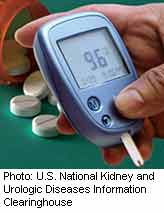
TUESDAY, Oct. 2 (HealthDay News) — New guidelines meant to provide type 2 diabetes patients with truly individualized care have been issued by the American Diabetes Association and the European Association for the Study of Diabetes.
The new position statement recommends more patient involvement in the treatment and management of their condition and gives guidance on the rational approach to the choice of therapy. Choices — including precise goals for blood sugar control — should combine the best available scientific evidence with the doctor’s and patient’s own preferences.
“Given the uncertainties in terms of type and sequence of therapies, this approach is particularly appropriate in type 2 diabetes,” Andrew Boulton, a professor at the University of Manchester, in England, and EASD president, said in a news release from the organization.
Among the other main points in the new guidelines:
- Diet, exercise and education remain the foundation of any type 2 diabetes treatment program.
- Unless there are good reasons for not using it, metformin (brand names include Fortamet, Glucophage, Glumetza and Riomet) is the best first-line drug.
- After metformin, there is limited data to guide treatment. Combination therapy with an additional one or two oral or injectable drugs is reasonable, aiming to minimize side effects where possible.
- Eventually, many patients will require insulin therapy alone or in combination with other drugs to maintain glucose control.
- Comprehensive cardiovascular risk reduction must be a major focus of therapy.
The guidelines were scheduled for release Tuesday at the annual meeting of the EASD, in Berlin, and appear in the journal Diabetologia.
In the guidelines, patient-centered care is defined as “an approach to providing care that is respective and responsive to individual patient preferences, needs and values, ensuring that the patients’ own values guide all clinical decisions.”
Ultimately, patients make the final decision about their lifestyle choices and, to some degree, the drug treatments they receive. Their diabetes care and management has to fit in with their lives.
More information
The American Diabetes Association has more about diabetes treatment and care.

